



Living in their Habitat
By Matt & Mary Lovein
Citation:
Lovein, M. & M. Lovein (2004). Living in their Habitat. Chameleons! Online E-Zine, August 2004. (http://www.chameleonnews.com/04AugLoveinLovein.html)
Hello E-Zine readers!
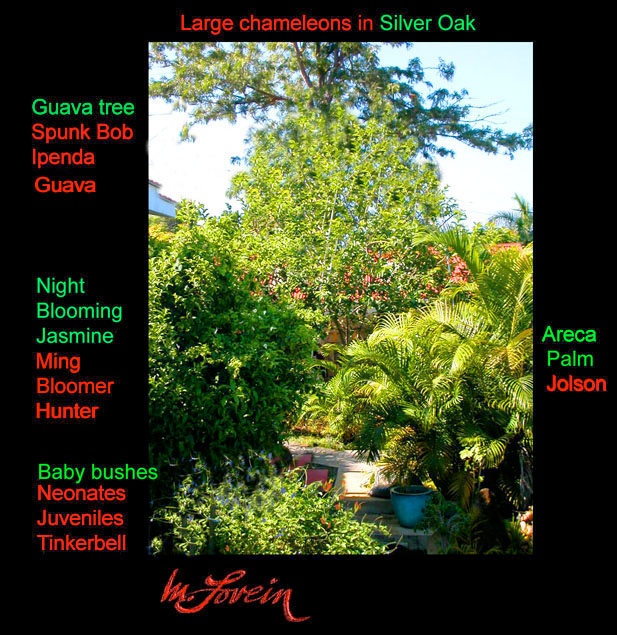
Welcome to a garden, with Chamaeleo (Trioceros) jacksonii xantholophus, a small glimpse into a big picture, on the Big Island of Hawaii. This location is in a private, gated community, surrounded by a forested area, which is a natural habitat to wild Jackson’s Chameleons. They can be spotted within minutes, in cham country, where the elevation and conditions are conducive to their needs.
When Matt and I, moved into this house, in 2001, we had not previously, observed any, in the environment, even though we were in this very same vicinity, just down the road, with our chameleons in cages. It was a profound epiphany, of sorts, to see a rogue male on the outside of Jill’s cage. We thought they must be in our midst, but still didn’t notice any right away. Since the realization that this area is rich with Jackson’s, we have both become avid watchers and appreciators, fascinated by everything about them.
In our passionate quest to learn as much as possible of their wondrous ways, it always leads to more questions and mysteries, concerning these amazing creatures. We respect them, as we live in their habitat. I would like to share with you a little bit about the Jackson’s we have seen recently, and a description of some of their habits and the nature of the immediate property:
In the front yard, there is a male and female, discovered yesterday in the Hibiscus nearest the road. She has some bright yellow pyramid patterns that seem to flicker like sunlight as she moves inside the bushes. In the Fish Tail palms at the end of the driveway, we see long-time residents, Squiggy and the Squiggerts, (females).

Next to the entry way by the front door, there is a juvenile female, named Areca. A young male, Mu, not quite eight months old, has recently chosen to move to this location, in plain view of Squiggy. They had a stare down for a few days, and now it seems that Mu has succeeded in claiming the Areca Palm real estate, at least for the time being, with Squiggy maintaining his position in the Fish Tails.
In the back yard Guava tree, there is a male, another long-time resident, Spunk Bob, and currently with two females, Ipenda, and Guava. In the Night Blooming Jasmine is a male, Hunter, two females, Ming and Bloomer. A small male, Jolson, resides in the palm near the back steps. There are several youngsters and Tinkerbell with the wiggly tail in the bushes and blue flowers. We make the rounds, looking for established residents, greeting returning travelers, honored guests, and first time visitors.
I am in the habit of looking at every branch, expecting to spot a chameleon, though, I am always surprised when I do. I continually evaluate shapes, hues, lights and shadows of images to use in my work, as a painter. Even so, I still find it challenging to spot chameleons. It is something of a talent with which I am not particularly gifted, but I am getting better with practice.
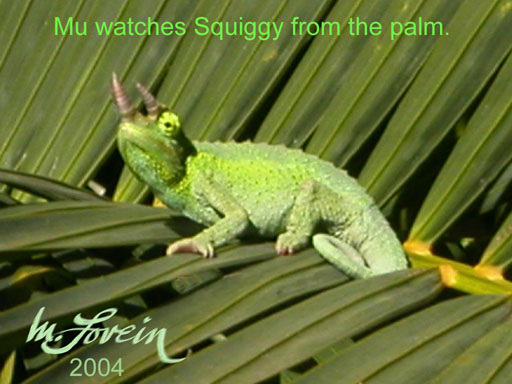
My husband, Matt, also an artist, is a champion at chameleon spotting. He sees an eyeball or just a tail and effortlessly picks it out of the foliage. I asked him how he does that and he said, "It's easy, I look for what is not the tree." He does use reading glasses for close work, but his distance vision and cham sighting ability is almost bionic.
Together we look for them, even before our coffee and newspaper. I miss this ritual when I am away from home, for any length of time, and always hope that the familiar residents will still be there, when I return, never certain that they will. It is a source of peaceful enjoyment, to see them in their glory, and evokes stillness and a reverent feeling.
We resist bringing offerings every day. We don’t want them to become reliant on us. When we do feed them, it is the ones that are easy to find, or ones that see us with the container and walk down the branches. We give them prey they might consider treats, which we collect locally: rock roaches, moths, pill bugs, grasshoppers, field spiders, inch worms, stick bugs, beetles and more. We also purchase crickets that are raised here in Hawaii and are usually referred to as house crickets.
From observing the Jackson's groupings, it seems that they practice what is known as resource polygyny. He guards the territory, mainly his immediate area of the canopy. This territory typically includes several females to which he seems to have reproductive access. The females can receive some security from not having to deal with unknown or subordinate males as well as the opportunity to mate with a male who has proven his superior fitness by winning and maintaining ownership of one of the more desirable locations. The groupings consist of Chameleons who can come and go, making their choices. Our yard is a safe place for them, and we do see the Jackson’s casually walking, on the ground, occasionally.
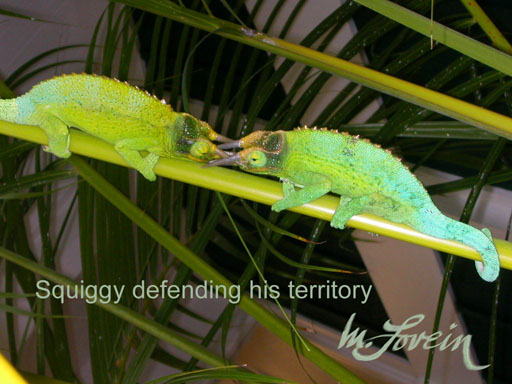
The males are more likely to wander away during part of the day, but upon their return, if a new male has moved in, there probably will be a confrontation. Presumably, to avoid this, a male with an established territory, that has sufficient resources, will rarely stray too far from home. The temptation of a receptive female or appetizing insects spotted nearby, could be a reason for him to risk a little trek to another tree. We never know if they will return again. The familiar presence of a beloved individual can suddenly disappear at any time.
The male is an opportunist and uses a head jerking display to continually check the females’ state of sexual receptivity. An unreceptive female signals her lack of interest, turning dark, with gaping and rocking behavior. The male, reverts to a more passive mode, and they will often settle within a branch or two, of each other, showing no stress colors. He watches and waits for the window of opportunity, when she is receptive. We have seen the male who would not take no for an answer pinned to the branch by a female getting her point across, until he surrenders.
The females seem to stay out of each other's way, though on occasion, will perch close together. We have seen them move, to join another established group or to find a new location. I have noticed that they will become restless before delivering a clutch and at that time, might choose to move temporarily, to a lower, denser area.
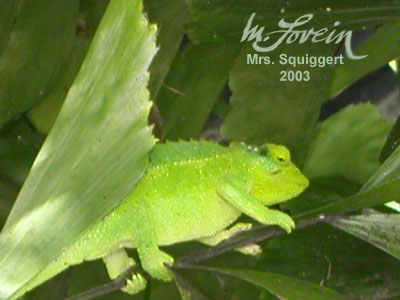
If a lone female takes up residence in a new different location, it is predictable that a male will soon appear. The radius of the territory, he determines, seems to depend on the thickness of the foliage and the visibility of other possible threats: the more lush, the foliage, the smaller the territory. When another adult male is too close for comfort, a horn-to-horn combat encounter may ensue, particularly if the intruder is similar in size to the resident male.
The alpha male will tolerate juvenile and sub adult males nearby who are usually found at a mid-level elevation, often in a different tree or bush. When they approach full maturity they may challenge another local male or choose to emigrate, looking for their own domain.
The Guava tree was guarded by a large male, Longhorns, and when he died Spunk Bob claimed that tree and moved out of the palm by the front entry. It is interesting that he made his move, so soon after the reigning Longhorns was gone, especially, because the trees are not in view of each other. He was also growing and was probably ready to find a more desirable or higher spot.
In 2003 we found a particularly stunning male that was approximately eight months old. We named him Sonny. He was living in the palm, near the entry to our front door. After a few months, we decided to keep him in an enclosure. When he reached his full adult size, he did not seem to be content with captivity, even though his cage was quite large. He could clearly see the females, that we also observed in a nearby Christmas Berry tree. He was starting to poke his horns out of the cage and then when he gave up on that, he became lethargic and his weight ballooned to 185 grams.

I struggled over whether or not to release him back into the environment he came from, and finally decided to let him free roam with supervision. I noticed that he immediately started climbing and using hunting skills with vigor. When I was satisfied that his feral instincts were still intact, in March of 2004, I released him into a nearby tree and left his cage door open, in case he wanted to return. After two days in the tree, he went for the bigger tree, which he had been eyeballing from the cage.
I felt a deep sense of loss, but my happiness for him outweighed the sadness. He is currently living so far at the top, I only occasionally see glimpses of his sherbet color and admire his muscular appearance using binoculars. We have noticed females near to him, and with his large size and impressive vitality, he is very capable of maintaining his penthouse position among other groupings in the same large tree.
It is a joy to simply pull up a chair and watch the Jackson’s, taking photos using a digital camera with a zoom. There are those, which appear to be completely, at ease with us, such as Spunk Bob, the ham cham.
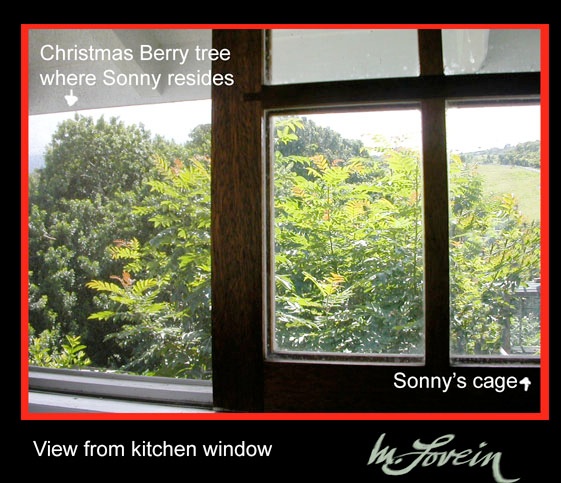
Our house is higher than the terrain, so that some of the tree tops are eye level with the windows. It is really something to see them when you least expect it, right in front of a window or holding on to an untrimmed branch that is a few inches from the outdoor breakfast table on the lanai. We are the ones in the enclosure as they seem to be curiously watching us.
On some days it is difficult to get anything done, especially when one of the trees rains babies and we discover a new clutch of little ones shooting their tiny tongues at fruit flies.
Until we meet again in the cham garden,
Best wishes and Aloha,
Mary Lovein
www.lovein.com


Matt & Mary Lovein

Matt and Mary Lovein are gallery owners in Holualoa, Hawaii. He is a ceramic artist and she is a painter. They observe Jackson's chameleons daily, as they live and work from their open air studios at their home. www.lovein.com









Join Our Facebook Page for Updates on New Issues:
© 2002-2014 Chameleonnews.com All rights reserved.
Reproduction in whole or part expressly forbidden without permission from the publisher. For permission, please contact the editor at editor@chameleonnews.com
